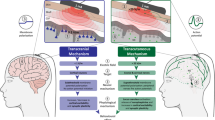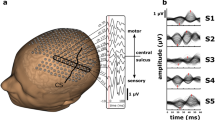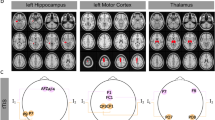Abstract
Despite its clinical relevance, direct electrical stimulation (DES) of the human brain is surprisingly poorly understood. Although we understand several aspects of electrical stimulation at the cellular level, surface DES evokes a complex summation effect in a large volume of brain tissue, and the effect is difficult to predict as it depends on many local and remote physiological and morphological factors. The complex stimulation effects are reflected in the heterogeneity of behavioural effects that are induced by DES, which range from evocation to inhibition of responses — sometimes even when DES is applied at the same cortical site. Thus, it is a misconception that DES — in contrast to other neuroscience techniques — allows us to draw unequivocal conclusions about the role of stimulated brain areas.
This is a preview of subscription content, access via your institution
Access options
Subscribe to this journal
Receive 12 print issues and online access
$189.00 per year
only $15.75 per issue
Buy this article
- Purchase on Springer Link
- Instant access to full article PDF
Prices may be subject to local taxes which are calculated during checkout


Similar content being viewed by others
References
Krause, F. Die operative Behandlung der Epilepsie. Med. Klin. 5, 1418–1422 (1909).
Krause, F. Surgery Of The Brain And Spinal Cord Based On Personal Experience Vol. 2 (Rebman, New York, 1912)
Cushing, H. A note upon the faradic stimulation of the postcentral gyrus in conscious patients. Brain 32, 44–53 (1909).
Ojemann, G. A., Ojemann, J. G., Lettich, E. & Berger, M. S. Cortical language localization in left, dominant hemisphere. An electrical stimulation mapping investigation in 117 patients. J. Neurosurg. 71, 316–326 (1989).
Ojemann, G. A. Cortical organization of language. J. Neurosci. 11, 2281–2287 (1991).
Duffau, H. et al. The role of dominant premotor cortex in language: a study using intraoperative functional mapping in awake patients. Neuroimage 20, 1903–1914 (2003).
Duffau, H. et al. New insights into the anatomo-functional connectivity of the semantic system: a study using cortico-subcortical electrostimulations. Brain 128, 797–810 (2005).
Sanai, N., Mirzadeh, Z. & Berger, M. S. Functional outcome after language mapping for glioma resection. N. Engl. J. Med. 358, 18–27 (2008).
Thiebaut De Schotten, M. et al. Direct evidence for a parietal-frontal pathway subserving spatial awareness in humans. Science 309, 2226–2228 (2005).
Gharabaghi, A., Fruhmann Berger, M., Tatagiba, M. & Karnath, H.-O. The role of the right superior temporal gyrus in visual search – insights from intraoperative electrical stimulation. Neuropsychologia 44, 2578–2581 (2006).
Mandonnet, E., Winkler, P. A. & Duffau, H. Direct electrical stimulation as an input gate into brain functional networks: principles, advantages and limitations. Acta Neurochir. 152, 185–193 (2010).
Desmurget, M. et al. Movement intention after parietal cortex stimulation in humans. Science 324, 811–813 (2009).
Penfield, W. & Roberts, L. Speech and Brain Mechanisms (Princeton Univ. Press, Princeton, New Jersey, 1959).
Van Buren, J. M., Fedio, P. & Frederick, G. C. Mechanism and localization of speech in the parietotemporal cortex. Neurosurgery 2, 233–239 (1978).
Ojemann, G. A. & Whitaker, H. A. The bilingual brain. Arch. Neurol. 35, 409–412 (1978).
Haglund, M. M., Berger, M. S., Shamseldin, E. L. & Ojemann, G. A. Cortical localization of temporal lobe language sites in patients with gliomas. Neurosurgery 34, 567–576 (1994).
Nossek, E. et al. Intraoperative mapping and monitoring of the corticospinal tracts with neurophysiological assessment and 3-dimensional ultrasonography-based navigation. J. Neurosurg. 114, 738–746 (2011).
Spena, G. et al. Preoperative and intraoperative brain mapping for the resection of eloquent-area tumors. A prospective analysis of methodology, correlation, and usefulness based on clinical outcomes. Acta Neurochir. 152, 1835–1846 (2010).
Ranck, J. B. Which elements are excited in electrical stimulation of mammalian central nervous-system: a review. Brain Res. 98, 417–440 (1975).
Gustafsson, B. & Jankowska, E. Direct and inderect activation of nerve-cells by electrical puses applied extracellularly. J. Physiol. 258, 33–61 (1976).
Nowak, L. G. & Bullier, J. Axons, but not cell bodies, are activated by electrical stimulation in cortical gray matter II. Evidence from selective inactivation of cell bodies and axon initial segments. Exp. Brain Res. 118, 489–500 (1998).
Rattay, F. The basic mechanism for the electrical stimulation of the nervous system. Neuroscience 89, 335–346 (1999).
Tehovnik, E. J., Tolias, A. S., Sultan, F. R., Slocum, W. M. & Logothetis, N. K. Direct and indirect activation of cortical neurons by electrical microstimulation. J. Neurophysiol. 96, 512–521 (2006).
Histed, M. H., Bonin, V. & Reid, R. C. Direct activation of sparse, distributed populations of cortical neurons by electrical microstimulation. Neuron 63, 508–522 (2009).
Logothetis, N. K. et al. The effects of electrical microstimulation on cortical signal propagation. Nature Neurosci. 13, 1283–1291 (2010).
Brunel, N. & van Rossum, M. C. W. Lapicque's 1907 paper: from frogs to integrate-and-fire. Biol. Cybern. 97, 337–339 (2007).
Irnich, W. The terms “chronaxie” and “rheobase” are 100 years old. Pacing Clin. Electrophysiol. 33, 491–496 (2010).
Mogyoros, I., Kiernan, M. C., Burke, D. & Bostock, H. Excitability changes in human sensory and motor axons during hyperventilation and ischaemia. Brain 120, 317–325 (1997).
Mogyoros, I., Kiernan, M. C., Burke, D. & Bostock, H. Strength-duration properties of sensory and motor axons in amyotrophic lateral sclerosis. Brain 121, 851–859 (1998).
Bostock, H. The strength duration relationship for excitation of myelinated nerve – computed dependence on membrane parameters. J. Physiol. 341, 59–74 (1983).
Mainen, Z. F., Joerges, J., Huguenard, J. R. & Sejnowski, T. J. A model of spike initiation in neocortical pyramidal neurons. Neuron 15, 1427–1439 (1995).
Tolias, A. S. et al. Mapping cortical activity elicited with electrical microstimulation using fMRI in the macaque. Neuron 48, 901–911 (2005).
Logothetis, N. K., Kayser, C. & Oeltermann, A. In vivo measurement of cortical impedance spectrum in monkeys: implications for signal propagation. Neuron 55, 809–823 (2007).
Asanuma, H., Arnold, A. & Zarzecki, P. Further study on the excitation of pyramidal tract cells by intracortical microstimulation. Exp. Brain Res. 26, 443–461 (1976).
Stoney, S. D., Thompson, W. D. & Asanuma, H. Excitation of pyramidal tract cells by intracortical microstimulation: effective extent of stimulating current. J. Neurophysiol. 31, 659–669 (1968).
Seidemann, E., Arieli, A., Grinvald, A. & Slovin, H. Dynamics of depolarization and hyperpolarization in the frontal cortex and saccade goal. Science 295, 862–865 (2002).
Butovas, S. & Schwarz, C. Spatiotemporal effects of microstimulation in rat neocortex: a parametric study using multielectrode recordings. J. Neurophys. 90, 3024–3039 (2003).
Berman, N. J., Douglas, R. J., Martin, K. A. & Whitteridge, D. Mechanisms of inhibition in cat visual cortex. J. Physiol. 440, 697–722 (1991).
Douglas, R. J., Martin, K. A. & Whitteridge, D. An intracellular analysis of the visual responses of neurones in cat visual cortex. J. Physiol. 440, 659–696 (1991).
Li, C. L. Cortical intracellular synaptic potentials in response to thalamic stimulation. J. Cell. Comp. Physiol. 61, 165–179 (1963).
Douglas, R. J. & Martin, K. A. C. Recurrent neuronal circuits in the neocortex. Curr. Biol. 17, R496–R500 (2007).
DeFelipe, J., Conley, M. & Jones, E. G. Long-range focal collateralization of axons arising from corticocortical cells in monkey sensory-motor cortex. J. Neurosci. 6, 3749–3766 (1986).
Keller, A. Intrinsic synaptic organization of the motor cortex. Cereb. Cortex 3, 430–441 (1993).
Logothetis, N. K. What we can do and what we cannot do with fMRI. Nature 453, 869–878 (2008).
Clark, K. L., Armstrong, K. M. & Moore, T. Probing neural circuitry and function with electrical microstimulation. Proc. Biol. Sci. 278, 1121–1130 (2011).
Cowey, A. The Ferrier Lecture 2004. What can transcranial magnetic stimulation tell us about how the brain works? Phil. Trans. R. Soc. B 360, 1185–1205 (2005).
Pollen, D. A. in The Nervous System Vol. 2 (ed. Tower, D. B.) 519–528 (Raven Press, New York, 1975).
Pollen, D. A. Response of single neurons to electrical stimulation of the surface of the visual cortex. Brain Behav. Evol. 14, 67–86 (1977).
Pollen, D. A. Brain stimulation and conscious experience. Conscious. Cogn. 13, 626–645 (2004).
Haglund, M. M., Ojemann, G. A. & Blasdel, G. G. Optical imaging of bipolar cortical stimulation. J. Neurosurg. 78, 785–793 (1993).
Haglund, M. M., Ojemann, G. A. & Hochman, D. W. Optical imaging of epileptiform and functional activity in human cerebral cortex. Nature 358, 668–671 (1992).
Haglund, M. M. & Hochman, D. W. Imaging of intrinsic optical signals in primate cortex during epileptiform activity. Epilepsia 48, 65–74 (2007).
Suh, M., Bahar, S., Mehta, A. D. & Schwartz, T. H. Blood volume and hemoglobin oxygenation response follwing electrical stimulation of human cortex. Neuroimage 31, 66–75 (2006).
Ishitobi, M. et al. Remote discharges in the posterior language area during basal temporal stimulation. Neuroreport 11, 2997–3000 (2000).
Matsumoto, R. et al. Functional connectivity in the human language system: a cortico-cortical evoked potential study. Brain 127, 2316–2330 (2004).
Matsumoto, R. et al. Functional connectivity in the human cortical motor system: a cortico-cortical evoked potential study. Brain 130, 181–197 (2007).
Penfield, W. & Boldrey, E. Somatic motor and sensory representation in the cerebral cortex of man as a studied by electrical stimulation. Brain 60, 389–443 (1937).
Brindley, G. S. & Lewin, W. S. The sensations produced by electrical stimulation of the visual cortex. J. Physiol. 196, 479–493 (1968).
Penfield, W. & Rasmussen, T. The Cerebral Cortex of Man: A Clinical Study of Localization of Function (Macmillan, New York, 1950).
Penfield, W. & Jasper, H. Epilepsy and the Functional Anatomy of the Human Brain (Little Brown, Boston, 1954).
Duffau, H. New concepts in surgery of WHO grade II gliomas: functional brain mapping, connectionism and plasticity – a review. Neuro-oncology 79, 77–115 (2006).
Pouratian, N., Cannestra, A. F., Bookheimer, S. Y., Martin, N. A. & Toga, A. W. Variability of intraoperative electrocortical stimulation mapping parameters across and within individuals. J. Neurosurg. 101, 458–466 (2004).
Karnath, H.-O., Borchers, S. & Himmelbach, M. Comment on “Movement intention after parietal cortex stimulation in humans”. Science 327, 1200 (2010).
Richer, F., Martinez, M., Robert, M., Bouvier, G. & Saint-Hilaire, J. M. Stimulation of human somatosensory cortex: tactile and body displacement perceptions in medial regions. Exp. Brain Res. 93, 173–176 (1993).
Fish., D. R., Gloor, P., Quesney, F. L. & Olivier, A. Clinical responses to electrical brain stimulation of the temporal and frontal lobes in patients with epilepsy. Pathophysiological implications. Brain 116, 397–414 (1993).
Fried, I. et al. Functional organization of human supplementary motor cortex studied by electrical stimulation. J. Neurosci. 11, 3656–3666 (1991).
Fritsch, G. & Hitzig, E. Über die elektrische Erregbarkeit des Grosshirns. Arch. Anat. Physiol. Wiss. Med. 37, 300–332 (1870).
Horsley, V. Case of occipital encephalocele in which a correct diagnosis was obtained by means of an induced current. Brain 7, 228–243 (1884).
Bidwell, L. A. & Sherrington, C. S. Focal epilepsy: trephining and removal of small hemorrhagic focus: no improvement; removal of part of leg centre after electrical stimulation: improvement. Br. Med. J. 2, 988–989 (1893).
Foerster, O. & Altenburger, H. Elektobiologische Vorgänge an der menschlichen Hirnrinde. Dtsche. Z. Nervenheilk. 135, 277–288 (1935).
Penfield, W. The electrode, the brain and the mind. Z. Neurol. 201, 291–309 (1972).
Farrell, D. F., Burbank, N., Lettich, E. & Ojemann, G. A. Individual variation in human motor-sensory (rolandic) cortex. J. Clin. Neurophysiol. 24, 286–293 (2007).
Acknowledgements
This work was supported by the Deutsche Forschungsgemeinschaft (grant KA 1258/10-1), the European Union (European Research Council grant StG 211078) and the Max Planck Society. The authors are grateful to W. Feindel, Literary Executor of the Estate of Wilder Penfield at the Montreal Neurological Institute, for suggestions and discussion regarding the history of DES.
Author information
Authors and Affiliations
Corresponding author
Ethics declarations
Competing interests
The authors declare no competing financial interests.
Related links
Glossary
- Afterdischarges
-
Neural discharges after termination of stimulation.
- Alexia
-
An acquired disorder of reading.
- Amplitude threshold
-
The voltage amplitude with which the stimulation pulse is applied.
- Anomia
-
Impaired recall of words, and naming errors.
- Antidromic
-
Conduction that is in the opposite direction to normal — that is, along the axon towards the soma of the neuron.
- BOLD signal
-
(Blood oxygen level-dependent signal). A measure of haemodynamic response based on changes in blood flow that are assumed to be related to neural activity in the brain.
- Chronaxie
-
The chronaxie time is the minimum length of time that is required to excite a neural element using half the intensity that elicits a threshold response.
- Electrocorticography
-
(ECoG). Recording of electrical activity from the cerebral cortex using electrodes placed directly on the exposed surface of the brain.
- Inhibitory surround
-
An inhibitory area of neurons around the excited area. The inhibitory surround accentuates the excited area and thereby enhances the contrast and sharpens discrimination.
- Intra-train facilitation
-
An increase in postsynaptic potential that is evoked by a series of pulses within a distinct time window.
- Optical imaging
-
Illumination of neuronal tissue with visible or near-infrared light; as changes in neural activity alter the light scattering and the absorption properties of brain tissue, the signals can be acquired with a digital video camera, with or without including (voltage-sensitive) dyes or contrast-enhancing agents.
- Orthodromic
-
Conduction along the axon in the normal direction — that is, away from the soma and towards the axon terminal.
- Paresthesia
-
Sensation of the skin, such as numbness, tingling or pricking.
- Phosphene
-
A phenomenon in which a person experiences seeing light without light actually entering the eye.
- Rheobase
-
The minimal current that is necessary to stimulate a neural element with a long stimulus duration is called the rheobase.
- Semantic paraphasias
-
Conditions in which a word is substituted with a word that is semantically related to the intended one by an aphasic individual.
- Transcranial magnetic stimulation
-
(TMS). A non-invasive method for inducing weak electric currents in the brain, thereby causing depolarization or hyperpolarization in neurons below the skull surface where the pulse is given.
Rights and permissions
About this article
Cite this article
Borchers, S., Himmelbach, M., Logothetis, N. et al. Direct electrical stimulation of human cortex — the gold standard for mapping brain functions?. Nat Rev Neurosci 13, 63–70 (2012). https://doi.org/10.1038/nrn3140
Published:
Issue Date:
DOI: https://doi.org/10.1038/nrn3140
This article is cited by
-
Flexible, scalable, high channel count stereo-electrode for recording in the human brain
Nature Communications (2024)
-
Implantable intracortical microelectrodes: reviewing the present with a focus on the future
Microsystems & Nanoengineering (2023)
-
New and emerging approaches to treat psychiatric disorders
Nature Medicine (2023)
-
Recent advances in the neuroscience of spontaneous and off-task thought: implications for mental health
Nature Mental Health (2023)
-
Localization patterns of speech and language errors during awake brain surgery: a systematic review
Neurosurgical Review (2023)



